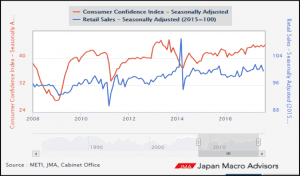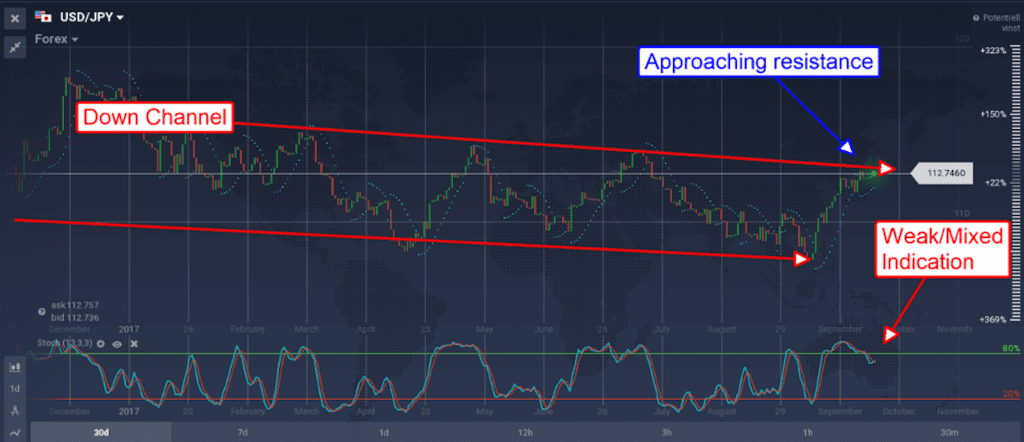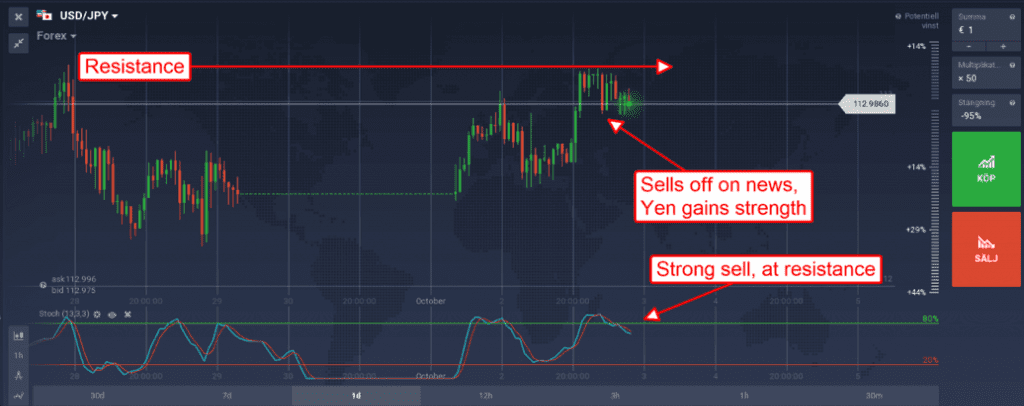Japanese Consumer Confidence has been on an upward trend leading the yen higher.
Consumer Confidence, Business Confidence And The BOJ
Japanese Consumer Confidence was released in the overnight hours and it came in strong, as expected. The headline index was expected to rise 0.2% to 42.5% to just under the long term highs, the actual reading was 43.9 matching a 4 year high. The index, which has been trending higher over the course of the last 2 years as Abenomics took hold in the economy, is likely to continue moving higher into the future.
Last month the index came in at 43.3%, dropping 0.5% on a decline in all four sub-components. Despite the drop the index remained near a 4 year high, just below the post-Great Recession high and in line with historic levels associated with economic stability. This month all four sub-components rose, reversing losses in the previous month. The four sub-components of the index are employment (up 0.4), overall livelihood (up 0.8), willingness to buy goods (up 0.9) and income growth (up 0.5).
The sub-indices are intended as a gauge of consumer health and used as a forward indicator of the economy. When the consumer is feeling good the rest of the economy should too and it is showing in Japan’s other data. Looking forward a whopping 76.2% of those surveyed say that the economy will continue to strengthen and that consumer prices would be higher a year from now.
 Retail sales has also been trending higher, in tandem with consumer confidence. The latest read had it just above the 100 level and near a multi-year high. The combination of easy-money policy, business friendly Abenomics, improvements in consumer confidence and retail sales have also helped to lift business sentiment. The Tankan Business Survey, conducted by the BOJ, was released earlier this week and shows improvement in Japanese business confidence across the manufacturing sector. The index of large manufacturers increased 5 points to 22 versus an expected 19 while the index of small manufacturers gained 3 points to hit 10 versus an expected 8.
Retail sales has also been trending higher, in tandem with consumer confidence. The latest read had it just above the 100 level and near a multi-year high. The combination of easy-money policy, business friendly Abenomics, improvements in consumer confidence and retail sales have also helped to lift business sentiment. The Tankan Business Survey, conducted by the BOJ, was released earlier this week and shows improvement in Japanese business confidence across the manufacturing sector. The index of large manufacturers increased 5 points to 22 versus an expected 19 while the index of small manufacturers gained 3 points to hit 10 versus an expected 8.
All this adds up to potential policy tightening from the BOJ. The bank has been on a mission to stimulate the economy for many years and is lagging other major central banks leaving easy-money policy in place long after signs of economic growth have returned. Both the FOMC and ECB have begun, or at least have indicated the beginning, of a cycle of policy tightening while the BOJ persists in leaving interest rates unchanged, bond purchased untouched. With signs of improvements in the economy the bank will have little choice but to begin tightening lest economic activity begin to increase at an unsustainable pace.

The yen has been trending higher versus the dollar over the past year, in tandem with consumer confidence, with periodic swings on shifting central bank sentiment. The USD/JPY pair is currently trading near the top of a long term down channel, lifted by recently firmed FOMC outlook, and poised to break out or confirm depending on this week’s data which includes today’s CC report. A strong round of data could lead to some expectation of BOJ tightening, a firming of the yen and a confirmation of the down channel. Weaker data could allow the dollar to continue on its upward path.

The consumer confidence was indeed strong and stronger than expected, resulting in a confirmation of resistance. The data suggests improvement within the economy at a fundamental level that may be confirmed with other data points to be released later this week. Tomorrow, Wednesday, Services PMI is expected to add a full percent and come in at an expansionary 52.5%. Thursday this will be backed up by a read on the Coincident and Leading Economic Indices which are also both expected to show expanding growth.
Resistance is currently just above 113.20 and confirmed by indicator and price action on the hourly chart. Stochastic and momentum both indicate lower prices with stochastic firing a strong sell following a bearish crossover. Near term support targets are near 112.90, 112.60 and then 112.30, a break below which would confirm reversal in the short term. The next BOJ meeting is at the end of the month with a scheduled policy announcement 31,October.

